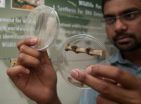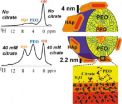(Press-News.org) PHILADELPHIA — Electrical engineers have long been toying with the idea of designing biological molecules that can be directly integrated into electronic circuits. University of Pennsylvania researchers have developed a way to form these structures so they can operate in open-air environments, and, more important, have developed a new microscope technique that can measure the electrical properties of these and similar devices.
The research was conducted by Dawn Bonnell, Trustee Chair Professor and director of the Nano/Bio Interface Center, graduate students Kendra Kathan-Galipeau and Maxim Nikiforov and postdoctoral fellow Sanjini Nanayakkara, all of the Department of Materials Science and Engineering in Penn's School of Engineering and Applied Science. They collaborated with assistant professor Bohdana Discher of the Department of Biophysics and Biochemistry at Penn's Perelman School of Medicine and Paul A. O'Brien, a graduate student in Penn's Biotechnology Masters Program.
Their work was published in the journal ACS Nano.
The development involves artificial proteins, bundles of peptide helices with a photoactive molecule inside. These proteins are arranged on electrodes, which are common feature of circuits that transmit electrical charges between metallic and non-metallic elements. When light is shined on the proteins, they convert photons into electrons and pass them to the electrode.
"It's a similar mechanism to what happens when plants absorb light, except in that case the electron is used for some chemistry that creates energy for the plant," Bonnell said. "In this case, we want to use the electron in electrical circuits."
Similar peptide assemblies had been studied in solution before by several groups and had been tested to show that they indeed react to light. But there was no way to quantify their ambient electrical properties, particularly capacitance, the amount of electrical charge the assembly holds.
"It's necessary to understand these kinds of properties in the molecules in order to make devices out of them. We've been studying silicon for 40 years, so we know what happens to electrons there," Bonnell said. "We didn't know what happens to electrons on dry electrodes with these proteins; we didn't even know if they would remain photoactive when attached to an electrode."
Designing circuits and devices with silicon is inherently easier than with proteins. The electrical properties of a large chunk of a single element can be measured and then scaled down, but complex molecules like these proteins cannot be scaled up. Diagnostic systems that could measure their properties with nanometer sensitivity simply did not exist.
The researchers therefore needed to invent both a new way of a measuring these properties and a controlled way of making the photovoltaic proteins that would resemble how they might eventually be incorporated into devices in open-air, everyday environments, rather than swimming in a chemical solution.
To solve the first problem, the team developed a new kind of atomic force microscope technique, known as torsional resonance nanoimpedance microscopy. Atomic force microscopes operate by bringing an extremely narrow silicon tip very close to a surface and measuring how the tip reacts, providing a spatial sensitivity of a few nanometers down to individual atoms.
"What we've done in our version is to use a metallic tip and put an oscillating electric field on it. By seeing how electrons react to the field, we're able to measure more complex interactions and more complex properties, such as capacitance," Bonnell said.
Bohdana Discher's group designed the self-assembling proteins much as they had done before but took the additional step of stamping them onto sheets of graphite electrodes. This manufacturing principle and the ability to measure the resulting devices could have a variety of applications.
"Photovoltaics — solar cells — are perhaps the easiest to imagine, but where this work is going in the shorter term is biochemical sensors," Bonnell said.
Instead of reacting to photons, proteins could be designed to produce a charge when in the presence of a certain toxins, either changing color or acting as a circuit element in a human-scale gadget.
###
This research was supported by the Nano/Bio Interface Center and the National Science Foundation.
Penn researchers develop biological circuit components, new microscope technique for measuring them
2011-06-09
ELSE PRESS RELEASES FROM THIS DATE:
New 3-D tumor model
2011-06-09
College Park, Md. (June 08, 2011) – A team of scientists has developed a way to coax tumor cells in the lab to grow into 3-D spheres. Their discovery takes advantage of an earlier technique of producing spherical cavities in a common polymer and promises more accurate tests of new cancer therapies.
As team leader Michael R. King, Ph.D., of Cornell University explains, "Sometimes engineering research tends to be a case of a hammer looking for a nail. We knew our previous discovery was new and it was cool. And now we know it's useful."
Three years ago, the team -- in ...
Ecology biased against non-native species?
2011-06-09
The recent field of invasion biology faces a new challenge as 19 eminent ecologists issue a call to "end the bias against non-native species" in the journal Nature.
Often called aliens, hitchhikers or invasives, some scientists say that non-native species could just as easily be coined "abductees" whose transport links to activities by humans.
The authors of the Nature comments section note that assumptions that "introduced species" offer only deleterious impacts are misguided and "that human-induced impacts, such as climate change, nitrogen eutrophication, urbanization ...
Saving wildlife with forensic genetics
2011-06-09
Wildlife face many threats with spreading urbanization, including habitat loss and inbreeding when populations become fragmented and isolated. It doesn't help that there is a billion-dollar international industry dedicated to the illegal trafficking of wild animals or wild animal parts.
The Conservation Genetics Lab at the University of Arizona is working to conserve and protect wild animals around the world.
"Our work here deals with using genetics for wildlife conservation," said Ashwin Naidu, a doctoral candidate in the School of Natural Resources and the Environment.
One ...
Researchers discover superatoms with magnetic shells
2011-06-09
RICHMOND, Va. (June 8, 2011) – A team of Virginia Commonwealth University scientists has discovered a new class of 'superatoms' – a stable cluster of atoms that can mimic different elements of the periodic table – with unusual magnetic characteristics.
The superatom contains magnetized magnesium atoms, an element traditionally considered as non-magnetic. The metallic character of magnesium along with infused magnetism may one day be used to create molecular electronic devices for the next generation of faster processors, larger memory storage and quantum computers.
In ...
Lifelong gap in health between rich and poor set by age 20
2011-06-09
"We can't buy our way out of ageing," says Nancy Ross, a McGill geography professor. "As we get older we start to have vision problems, maybe some hearing loss, maybe lose some mobility – ageing is a kind of a social equalizer."
Ross is the lead author of a new study about how socio-economic and educational status affects Canadians' health-related quality of life over the course of a lifetime.
"My research looks at how poverty and social disadvantage affect your health status. Our work was about using social circumstances as a lens to look at how people's quality ...
Citrate key in bone's nanostructure
2011-06-09
AMES, Iowa - Bone is one of nature's surprising "building materials." Pound-for-pound it's stronger than steel, tough yet resilient. Scientists at the U.S. Department of Energy's Ames Laboratory have identified the composition that gives bone its outstanding properties and the important role citrate plays, work that may help science better understand and treat or prevent bone diseases such as osteoporosis.
Using nuclear magnetic resonance (NMR) spectroscopy, Ames Laboratory scientist and Iowa State University chemistry professor Klaus Schmidt-Rohr and his colleagues ...
Will psych majors make the big bucks?
2011-06-09
A new crop of college graduates have just landed on the job market. Right now they're probably just hoping to get any job, if at all. However, for psychology majors, the salary outlook in both the short and long term is particularly poor, according to a new study which will be published in an upcoming issue of Perspectives on Psychological Science, a journal of the Association for Psychological Science.
It's generally known that psychology majors don't make a ton of money when they're starting out; they're not like engineering students, many of whom go straight into a ...
How cells' sensing hairs are made
2011-06-09
Body cells detect signals that control their behavior through tiny hairs on the cell surface called cilia. Serious diseases and disorders can result when these cilia do not work properly. New research from UC Davis published this week in the journal Nature Cell Biology provides new insights into how these cilia are assembled.
"It's a basic discovery, but with implications for understanding disease," said Jonathan Scholey, professor of molecular and cellular biology at UC Davis and senior author of the study. Understanding how cilia are assembled and function can help ...
'Thermal pollution' in rivers not fully mediated by gravel augmentation
2011-06-09
Although adding gravel to a river to replace lost sediments won't likely cool the whole river channel, it can create cool water refuges that protect fish from thermal pollution, according to a U.S. Forest Service Pacific Northwest Research Station study.
The research—featured in the June 2011 issue of Science Findings, a monthly publication of the station—is among the first to explore the interplay between sub-surface water flow and temperature in large rivers and is helping to guide river restoration strategies in the Pacific Northwest.
In the study, which began ...
Eating a high-fat diet may rapidly injure brain cells that control body weight
2011-06-09
Obesity among people who eat a high-fat diet may involve injury to neurons, or nerve cells, in a key part of the brain that controls body weight, according to the authors of a new animal study. The results will be presented Tuesday at The Endocrine Society's 93rd Annual Meeting in Boston.
"The possibility that brain injury may be a consequence of the overconsumption of a typical American diet offers a new explanation for why sustained weight loss is so difficult for most obese individuals to achieve," said presenting author Joshua Thaler, MD, PhD, a faculty member with ...


